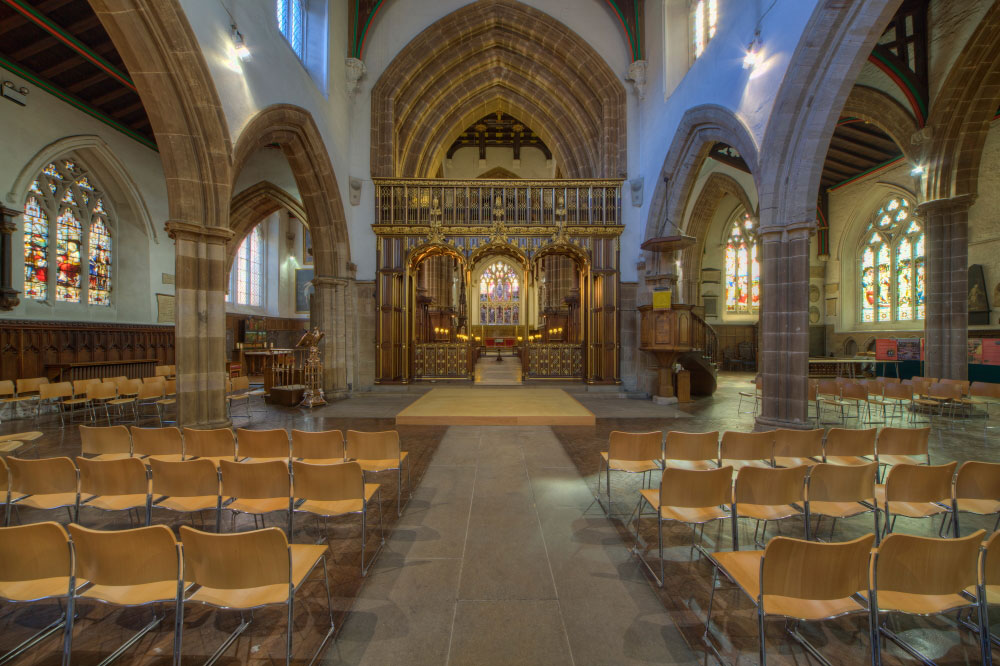
Photo taken in 2012 before planned changes for Richard III re-internment
Leicester does not have a cathedral to match the splendour of Salisbury, York or Lincoln. In fact St Martin’s is an enlarged parish church that was ‘nominated’ to cathedral status in 1927. There was discussion at the time that the nearby church of St Margaret’s or even the grand church at Melton Mowbray would be better alternatives, but in the end St Martins was chosen over the rivals.
Leicester was an important Roman town (Ratae) and perhaps would have had an early Christian church. Whether this was on the site of St Martins is open to conjecture but there was an earlier Saxon church on the site and St Martin the patron saint was a converted Roman soldier who performed miracles who became a hermit.
The church is first mentioned in 1220 when it belonged to Leicester Abbey and in 1225 the Bishop of Lincoln ordained a vicarage. The advowson passed to the Crown at the Dissolution until 1867 when it passed to the Bishop of Peterborough, it is now vested in the Bishop of Leicester.
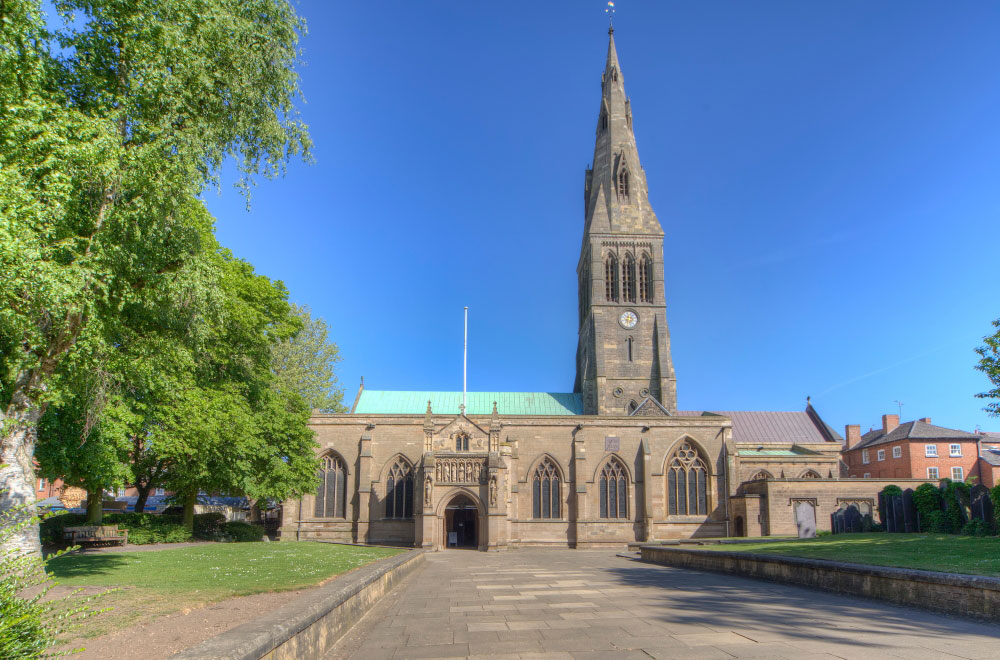
The view from the south with the tall Victorian spire .
The church has been closely associated with guilds during the medieval period and several were closely tied with the church. The guild of Corpus Christi was founded in 1343 as a social and religious guild attached to St. Martin’s Church, with four chaplains and endowed with lands to the value of £20 a year. They built a hall to the west of the church that became closely knit with the local town government, its ‘guildhall’ was used for meetings of the town council from the 15th century. Today the Guilldhall is still there as a museum and is well worth a visit. The guild of Corpus Christi was dissolved in 1548 and the vicar of St Martin’s at the time complained that without the chaplains help he would be unable to complete his parish duties.
The vicar at that time had a house next to the guildhall which was built in January 1457/58. The vicars lived there until 1760 when the house was demolished to extend the burial ground. For his loss he was given 10 shillings a year. This ‘new’ burial ground is now perhaps under the car park to the west of the cathedral.
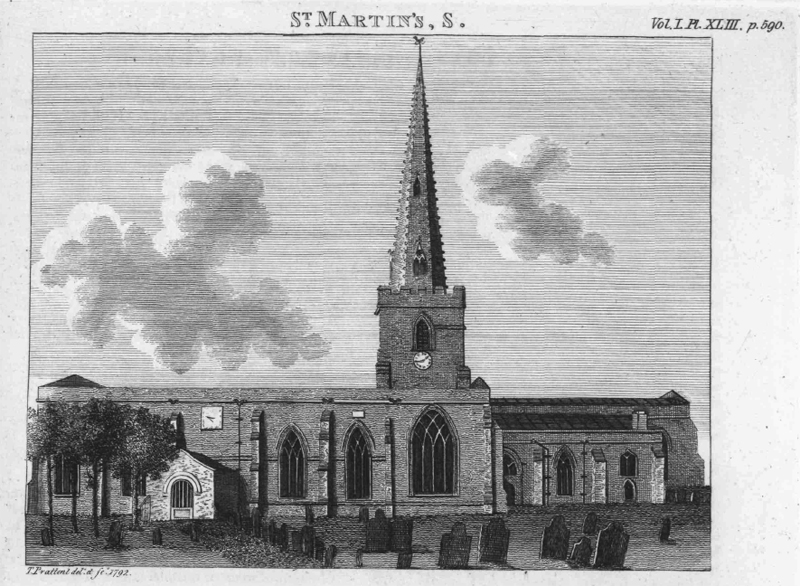
The original tower and spire can be seen in this sketch taken in late 18th century.
A guild of St George is first mentioned in 1499 when the 48 members are asked to pay for it’s upkeep. The annual festival of the guild was the ceremony of ‘Riding St George’ in which the guild paraded as St George and the Dragon. However in 1543 the master of the guild was fined for not riding the ‘George’ and it is not mentioned again.
In 1528 the parishioners complained that ‘the clergy laughed and talked together during services and omitted to wear their surplices’. The vicar generally sent a Franciscan friar to visit the sick, and the friar was described as both neglectful and indiscreet.
By 1575 the church had long been regarded as the principal church in the borough and it was ordered that two or three members of every household in the borough and its suburbs should attend the Wednesday and Friday sermons in the church.
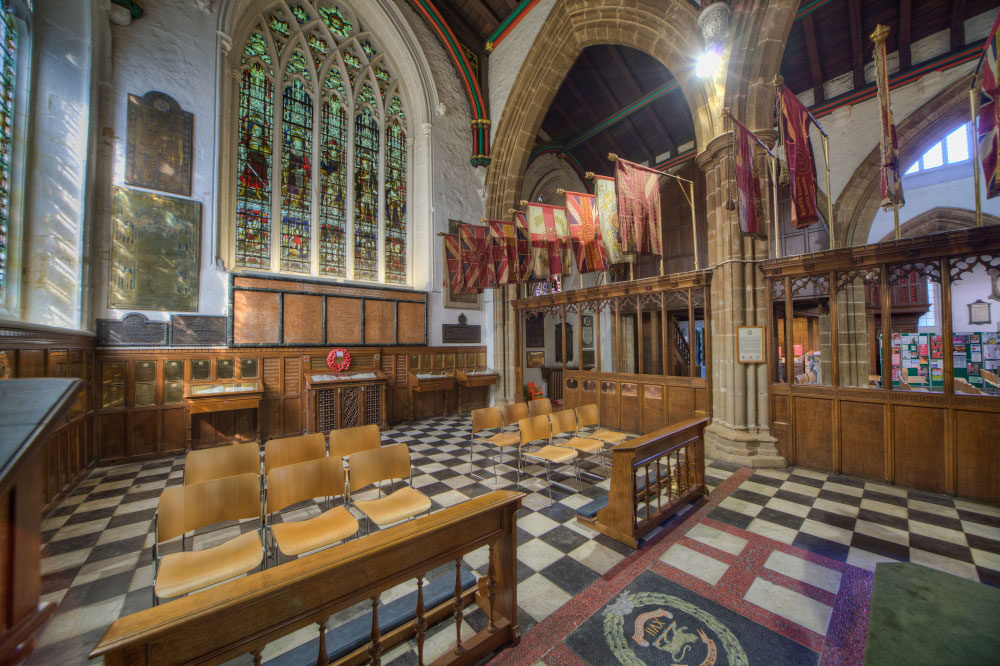
The Leicestershire Regiment War memorial chapel in the south aisle
In February 1927 St Martins was hallowed as the cathedral and Dr Cyril Bardsley was appointed the first Bishop.
The church is a cruciform building dating back to the 12th century which originally had narrow aisles. Today it consists of a central tower and spire, two storey south porch, large nave, north aisle with double south aisle, choir (below tower), chancel, and two chapels from the chancel one being St Katherine’s and the other St Dunstan’s. There are also some clergy rooms to the south east.
Much of the fabric dates from the 13-14th centuries although the Victorians completed several restorations on the building and there were other changes when it became the cathedral. The central tower dates to the 13th century, the large second south aisle was added in the 14th century and in the 15th century the chancel was rebuilt and the two chapel added to it. The clerestory and west doorway date to the late 15th or early 16th centuries. In 1545-46 one of the aisles was extensively repaired and in 1633 the churchwardens repaired the chancel.
From 1846-1867 the church was restored by John Raphael Brandon with new roofs being built in 1847-48. The piers between the nave and north aisle were replaced and the southern ones were restored in 1851, the church was also re-seated during this period.
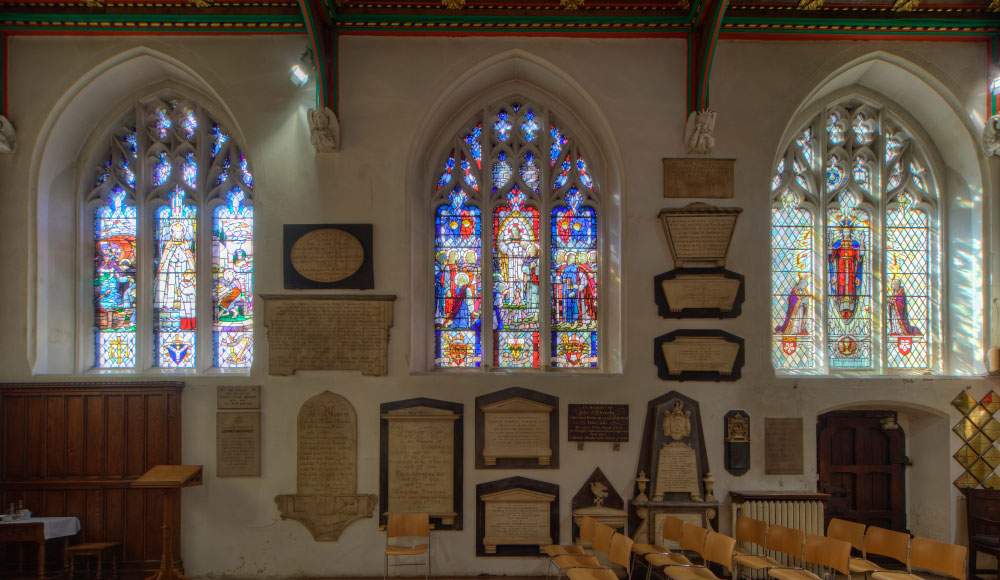
Some of the memorials and fine glass in the south aisle
The tower rebuild was perhaps his greatest work. The Norman supporting pillars and the tower were demolished in 1861 and replaced by a completely new tower (1861-62) and spire (1867) which rise to 220 feet.
In the late 1890’s the south aisle was restored by J. L. Pearson and in 1897 the south Vaughan porch was added by G. F. Bodley in memory of Edward Vaughan and his three sons. Sir Charles Nicolson became architect when the church was created a cathedral and was assisted by William Keay of Leicester. The sacristy was built in 1927 and the vestries in 1939.
St Katherine’s chapel was rebuilt in 1865 and was also known as the Herrick chapel and contains a number of memorials to the family. Sadly in 1847 a medieval painting of St Katherine was obliterated on the north wall.
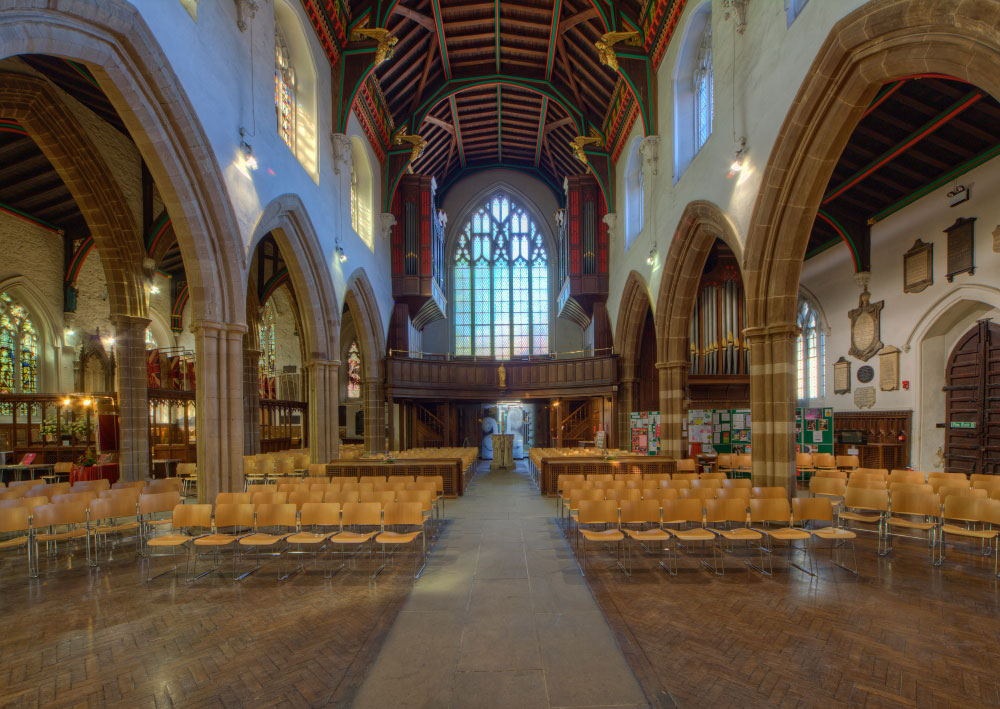
The west gallery added in te 1920’s with a modern entrance
St Dunstan’s chapel was rebuilt in the at the same time and was dedicated to the Needham family. The west gallery was completed in 1930, the font is Victorian and all the wood panelling date to the first half of the 20th century. Before the Reformation there were five chapels in the church. The Lady Chapel used by the Corpus Christi guild was in the outer south aisle, St George’s Chapel was located where the present War Memorial chapel of the Leicestershire Regiment is sited at the west end.

Sketches from late 18th century of memorials
There are various monuments scattered throughout the building mostly to the great and good of the city and although they have some interest there is not anything of great significance. The east window is very fine and there are are some good stained glass around the building. The cathedral is now part of the St Martins square project with Leicester Diocese having refurbished offices nearby and they have made the ‘Cathedral Square’ a much more attractive space with gardens and more open space.
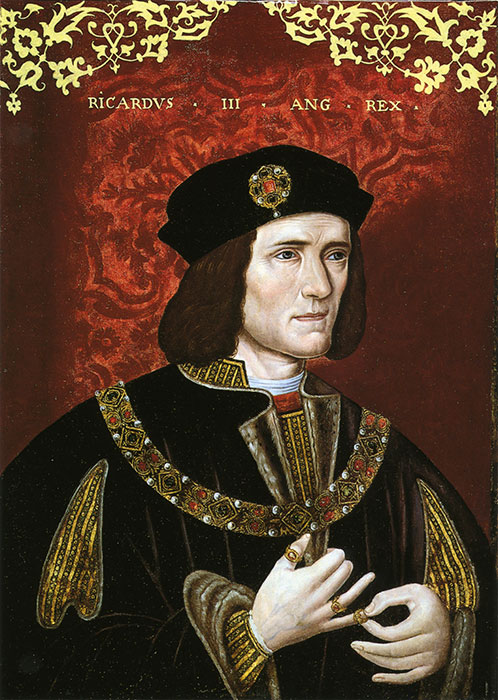
The most important change to St Martins is of course the internment of King Richard III this coming March 2015. This is perhaps one of the most important events for the Cathedral and the City itself in many years. There was a memorial stone to King Richard III in the chancel between the stalls (installed 1980 – see 360° virtual tour below) which stated that he was buried in the parish at Greyfriars graveyard in 1485 after the Battle of Bosworth. You can find out much more at the link here. This virtual tour was completed in 2012, a new 360° tour will be completed in May 2015 and this page will be updated with new photos.
With the King Richard III Centre, Guildhall, The Roman baths and museums nearby there is plenty to see and do, and of course you are only two minutes away from the shops and cafes of the city. The Cathedral is always open and worth a visit, you can spend a good couple of hours looking around inside, but wait until after March 2015…



March 11, 2015
I happened upon your site by chance this afternoon and have read all the posts here in one sitting. I live in N Essex and have visited all pre 1900 Essex churches, all but 4 Herts (I’m trying to find time to finish them off!) and various Cambs, Suffolk and elsewhere churches – I’ve currently visited 1049 mostly East Anglian and other SE churches.
This has obviously given me a bias in favour of flint and clunch built architecture but I have to admit that I am deeply jealous, and subsumed with admiration for, the Leicestershire and Rutland style – Tickencote has gone straight to the top of my must see before I die church list (Leicester Cathedral was already on a seperate English cathedra list).
Brilliant site but excuse me while I go off to read the A-Z entries.
March 13, 2015
Thankyou David for your comments. I am not even in the same league as yourself – 1049!!
I have completed around 200 but after a break I am now enjoying getting back to visiting the churches. I travel for business so I will take a look at your site for inspiration when I am down in your area.
October 17, 2016
Hi
I live in Glenfield and have visited the cathedral a few times, but have never seen any Leicestershire Volunteer Colours of the Volunteers of 1798-1802 1802-1814 hanging in the Cathedral.
Were they deposited in the Cathedral ?
Do you still have any ?
Could I see them if you do ?
Which ones still exist ?
Which ones have you got ?
Do you have any information of the design of ones you have had, but no longer possess ?
I would appreciate your help, please
guy
May 6, 2024
I have a question regarding the baptismal register of the Cathedral covering the 1670s (if it or a copy still remains at the Cathedral). I am researching a composer, Robert Valentine (‘Follintine’ in the register) reported to have been christened at St Martin on 16 January 1673. At this time the year advanced not on 1 January but on 25 March (Lady Day), so during that period one would expect the entries for January of any year to be ‘a year behind’ the correct year according to the modern system. What I cannot tell, since my information comes from secondary sources, is whether the year of the entry in the register is 1672 (and has already been converted to the modern system), or is indeed 1673 — and should be advanced to 1674. Can you help me?